
The chivi vireo is a small South American songbird in the family Vireonidae. It was formerly considered a subspecies of the red-eyed vireo. It is usually green to yellow-green in color with off-white underparts, and a gray crown. It has a whitish supercilium extending over its ear coverts, and its lores are dull gray in color. The chivi vireo has nine subspecies. It is found throughout most of northern, eastern and central South America, only being absent from southern Chile and southern Argentina. It inhabits multiple types of habitat across its range, and appears to adjust well to slightly disturbed habitat. The chivi vireo is mainly resident, but at least two of the subspecies inhabiting the south of its range are known to be migratory.

The fork-tailed flycatcher is a passerine bird of the tyrant flycatcher family and is a member of a genus typically referred to as kingbirds. Named for their distinguishably long, forked tail, fork-tailed flycatchers are seen in lightly forested or grassland areas, from southern Mexico to south past Argentina. They are most frequently observed sitting on conspicuous perches waiting for flying arthropods to fly past, they then sally out, eat their prey, and return to their perches. Northern populations near southern Mexico tend to be permanent residents, while fork-tailed flycatchers that live further south are migrants with a reputation for wandering to as far north as New Brunswick, Canada.

The sharp-billed canastero or lesser canastero is a species of bird in the Furnariinae subfamily of the ovenbird family Furnariidae. It is found in Argentina, Bolivia, Chile, Paraguay, and Uruguay, and has also occurred as a vagrant in Brazil.

The lesser elaenia is a species of bird in subfamily Elaeniinae of family Tyrannidae, the tyrant flycatchers. It is found in Costa Rica, Panama, on Trinidad, in every mainland South American country except Chile and Uruguay, and as a vagrant on Bonaire and Curaçao.

The cliff flycatcher is a species of bird in the tyrant flycatcher family, Tyrannidae. The cliff flycatcher is the only species in the genus Hirundinea after the swallow flycatcher was merged, becoming subspecies Hirundinea ferruginea bellicosa. It is native to South America, where its natural habitats are cliffs and crags in the vicinity of subtropical or tropical dry forest, subtropical or tropical moist lowland forest, subtropical or tropical moist montane forest, and heavily degraded former forest.

The narrow-billed woodcreeper is a species of bird in the subfamily Dendrocolaptinae of the ovenbird family Furnariidae. It is found in Argentina, Bolivia, Brazil, Paraguay, Suriname, and Uruguay.
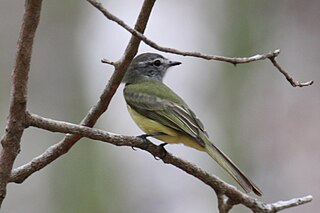
The greenish elaenia is a species of bird in subfamily Elaeniinae of family Tyrannidae, the tyrant flycatchers. It is found in Mexico, every Central American country, and every mainland South American country except Chile and French Guiana. It has also occurred as a vagrant in southern Texas.

The rough-legged tyrannulet is a species of bird in subfamily Elaeniinae of family Tyrannidae, the tyrant flycatchers. It is found in Argentina, Bolivia, Brazil, Paraguay, and Uruguay.
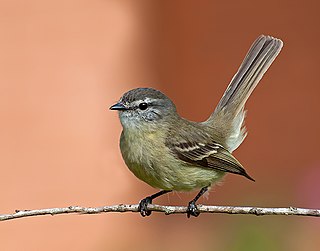
The planalto tyrannulet is a species of bird in subfamily Elaeniinae of family Tyrannidae, the tyrant flycatchers. It is found in Argentina, Bolivia, Brazil, and Paraguay.

Reiser's tyrannulet is a species of bird in subfamily Elaeniinae of family Tyrannidae, the tyrant flycatchers. It is found in Brazil and Paraguay.

The sooty tyrannulet is a species of bird in the family Tyrannidae, the tyrant flycatchers. It is small, usually weighing 9 grams with a length of 12 centimeters, and has gray or brownish-grey feathers with black tail feathers. It is found in Argentina, Brazil, and Uruguay; also southern Paraguay. A small extension of its range is in southeastern Bolivia.

The chapada flycatcher is a Near Threatened species of bird in subfamily Fluvicolinae of family Tyrannidae, the tyrant flycatchers. It is found in Bolivia and Brazil.

The white-throated woodcreeper is a species of bird in the subfamily Dendrocolaptinae of the ovenbird family Furnariidae. It is found in Argentina, Brazil, and Paraguay.

The campo flicker is a species of bird in subfamily Picinae of the woodpecker family Picidae. It is found in Argentina, Bolivia, Brazil, Paraguay, Suriname, and Uruguay.
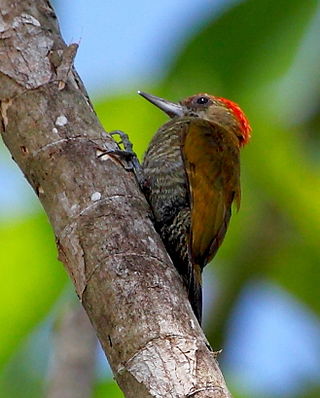
The red-stained woodpecker is a species of bird in subfamily Picinae of the woodpecker family Picidae. It is found in Bolivia, Brazil, Colombia, Ecuador, Peru, and Venezuela.

The Santarém parakeet, also known as Hellmayr's parakeet or in aviculture as Hellmayr's conure or the Santarém conure, is a species of parrot in the family Psittacidae. It is found in the eastern and central sections of the Amazon basin south of the Amazon River, only just extending onto the northern bank of this river.
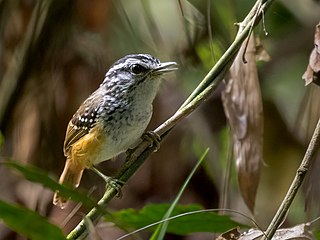
Spix's warbling antbird or Spix's antwarbler, is a species of bird in subfamily Thamnophilinae of family Thamnophilidae, the "typical antbirds". It is endemic to Amazonian Brazil.

The white-fronted tyrannulet is a species of bird in subfamily Elaeniinae of family Tyrannidae, the tyrant flycatchers. It is found in Bolivia, Colombia, Costa Rica, Ecuador, Panama, Peru, and Venezuela.
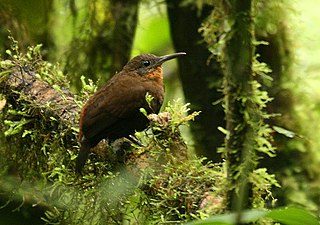
The dusky leaftosser or South American leaftosser is a bird in subfamily Sclerurinae, the leaftossers and miners, of the ovenbird family Furnariidae. It is found in Bolivia, Brazil, Colombia, Ecuador, French Giana, Guyana, Panama, Peru, Suriname, and Venezuela.























